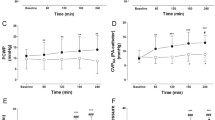Abstract
Purpose
The purpose of this large-animal study was to assess the safety and effects of negative pressure therapy (NPT) when used as temporary abdominal closure in the immediate post-decompression period after abdominal compartment syndrome (ACS).
Methods
Using a hemorrhagic shock/resuscitation and mesenteric venous pressure elevation model, ACS was physiologically induced in 12 female Yorkshire swine. At decompression, animals were allocated to either NPT (n = 6) or Bogota bag (n = 6) as temporary abdominal closure and studied for a period of 48 h or until death. Outcomes measured included morbidity and mortality, as well as hemodynamic parameters, ventilator-related measurements, blood gases, coagulation factors, and organ (liver, kidney, lung, and intestinal) edema and histology at the time of death/sacrifice.
Results
All animals developed ACS. Early application of NPT was associated with decreases in mesenteric venous and central venous pressure, and significantly increased drainage of peritoneal fluid. In addition, there was no increase in the incidence of mortality, recurrent intra-abdominal hypertension/ACS, or any deleterious effects on markers of organ injury.
Conclusions
Early application of NPT in this porcine ACS model is safe and does not appear to be associated with an increased risk of recurrent intra-abdominal hypertension. The results of this animal study suggest that the application of NPT following decompression from ACS results in greater peritoneal fluid removal and may translate into augmented intestinal edema resolution secondary to more favorable fluid flux profiles.


Similar content being viewed by others
References
Malbrain ML, Cheatham ML, Kirkpatrick A, Sugrue M, Parr M, De Waele J, et al. Results from the International Conference of Experts on Intra-abdominal Hypertension and Abdominal Compartment Syndrome. I. Definitions. Intensive Care Med. 2006;32(11):1722–32. doi:10.1007/s00134-006-0349-5.
Balogh ZJ, van Wessem K, Yoshino O, Moore FA. Postinjury abdominal compartment syndrome: are we winning the battle? World J Surg. 2009;33(6):1134–41. doi:10.1007/s00268-009-0002-x.
De Waele JJ, Hoste EA, Malbrain ML. Decompressive laparotomy for abdominal compartment syndrome—a critical analysis. Crit Care. 2006;10(2):R51. doi:10.1186/cc4870.
MacLean AA, O’Keeffe T, Augenstein J. Management strategies for the open abdomen: survey of the American Association for the Surgery of Trauma membership. Acta Chir Belg. 2008;108(2):212–8.
Kubiak BD, Albert SP, Gatto LA, Snyder KP, Maier KG, Vieau CJ, et al. Peritoneal negative pressure therapy prevents multiple organ injury in a chronic porcine sepsis and ischemia/reperfusion model. Shock. 2010;34(5)525–34.
Benninger E, Laschke MW, Cardell M, Keel M, Seifert B, Trentz O, et al. Intra-abdominal pressure development after different temporary abdominal closure techniques in a porcine model. J Trauma. 2009;66(4):1118–24. doi:10.1097/TA.0b013e3181820d94.
Benninger E, Labler L, Seifert B, Trentz O, Menger MD, Meier C. In vitro comparison of intra-abdominal hypertension development after different temporary abdominal closure techniques. J Surg Res. 2008;144(1):102–6. doi:10.1016/j.jss.2007.02.021.
Shah SK, Jimenez F, Walker PA, Xue H, Uray KS, Aroom KR et al. A novel physiologic model for the study of abdominal compartment syndrome (ACS). J Trauma. 2010;68(3):682–9. doi:10.1097/TA.0b013e3181c453cb.
Kirshtein B, Roy-Shapira A, Lantsberg L, Mizrahi S. Use of the “Bogota bag” for temporary abdominal closure in patients with secondary peritonitis. Am Surg. 2007;73(3):249–52.
Shah SK, Jimenez F, Walker PA, Aroom KR, Xue H, Feeley TD, et al. A novel mechanism for neutrophil priming in trauma: potential role of peritoneal fluid. Surgery. 2010;148(2):263–70. doi:10.1016/j.surg.2010.03.019.
Schachtrupp A, Wauters J, Wilmer A. What is the best animal model for ACS? Acta Clin Belg Suppl. 2007;225–32.
Moore-Olufemi SD, Xue H, Allen SJ, Moore FA, Stewart RH, Laine GA, et al. Effects of primary and secondary intra-abdominal hypertension on mesenteric lymph flow: implications for the abdominal compartment syndrome. Shock. 2005;23(6):571–5. doi:00024382-200506000-00015[pii].
Wauters J, Claus P, Brosens N, McLaughlin M, Malbrain M, Wilmer A. Pathophysiology of renal hemodynamics and renal cortical microcirculation in a porcine model of elevated intra-abdominal pressure. J Trauma. 2009;66(3):713–9. doi:10.1097/TA.0b013e31817c5594.
Schachtrupp A, Lawong G, Afify M, Graf J, Toens C, Schumpelick V. Fluid resuscitation preserves cardiac output but cannot prevent organ damage in a porcine model during 24 h of intraabdominal hypertension. Shock. 2005;24(2):153–8. doi:00024382-200508000-00009[pii].
Schachtrupp A, Graf J, Tons C, Hoer J, Fackeldey V, Schumpelick V. Intravascular volume depletion in a 24-hour porcine model of intra-abdominal hypertension. J Trauma. 2003;55(4):734–40. doi:10.1097/01.TA.0000042020.09010.D7.
Toens C, Schachtrupp A, Hoer J, Junge K, Klosterhalfen B, Schumpelick V. A porcine model of the abdominal compartment syndrome. Shock. 2002;18(4):316–21.
Engum SA, Kogon B, Jensen E, Isch J, Balanoff C, Grosfeld JL. Gastric tonometry and direct intraabdominal pressure monitoring in abdominal compartment syndrome. J Pediatr Surg. 2002;37(2):214–8. doi:S0022346802415485[pii].
Tarpila E, Nyström PO, Ihse I. The resorption of FITC-dextran 10,000 from the peritoneum in different modifications of bile-induced acute pancreatitis and in bacterial peritonitis. Int J Pancreatol. 1991;10(3–4):229–36.
Ishimaru K, Mitsuoka H, Unno N, Inuzuka K, Nakamura S, Schmid-Schönbein GW. Pancreatic proteases and inflammatory mediators in peritoneal fluid during splanchnic arterial occlusion and reperfusion. Shock. 2004;22(5):467–71. doi:00024382-200411000-00011[pii].
Radhakrishnan RS, Shah SK, Lance SH, Radhakrishnan HR, Xue H, Radhakrishnan GL, et al. Hypertonic saline alters hydraulic conductivity and up-regulates mucosal/submucosal aquaporin 4 in resuscitation-induced intestinal edema. Crit Care Med. 2009;37(11):2946–52. doi:10.1097/CCM.0b013e3181ab878b.
Acknowledgments
This study was supported by NIH Grants T32 GM 0879201 and RO1 HL 092916; Children’s Memorial Hermann Hospital Foundation; Texas Higher Education Coordination Board; Kinetic Concepts, Inc.
Conflict of interest
Funding for this project was provided, in part, by a grant from Kinetic Concepts, Inc. (to Charles S. Cox, Jr, MD).
Author information
Authors and Affiliations
Corresponding author
Electronic supplementary material
Below is the link to the electronic supplementary material.
Rights and permissions
About this article
Cite this article
Shah, S.K., Jimenez, F., Walker, P.A. et al. Evaluating the effects of immediate application of negative pressure therapy after decompression from abdominal compartment syndrome in an experimental porcine model. Eur J Trauma Emerg Surg 38, 65–73 (2012). https://doi.org/10.1007/s00068-011-0136-z
Received:
Accepted:
Published:
Issue Date:
DOI: https://doi.org/10.1007/s00068-011-0136-z




